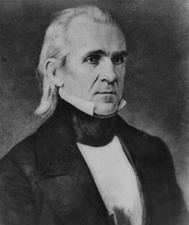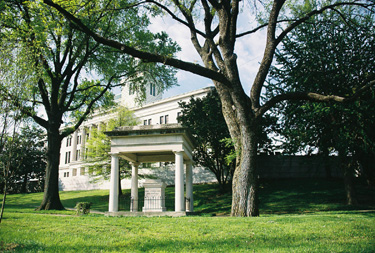 My wife Debbie and I took a trip
to Nashville, Tennessee
in August of 2007 for a week vacation. While we were in Nashville, we
got to visit two more dead presidents. On our first day, Monday morning
April 9, we drove to
the state capital building to get James Knox Polk, the 28th Dead
President in my collection. Later that week, we visited the Hermitage
and got Andrew Jackson. I now have only nine to go.
My wife Debbie and I took a trip
to Nashville, Tennessee
in August of 2007 for a week vacation. While we were in Nashville, we
got to visit two more dead presidents. On our first day, Monday morning
April 9, we drove to
the state capital building to get James Knox Polk, the 28th Dead
President in my collection. Later that week, we visited the Hermitage
and got Andrew Jackson. I now have only nine to go.Polk, the first of ten children, was born in a log farmhouse in what is now Pineville, North Carolina in Mecklenburg County in 1795, just outside of Charlotte. His father, Samuel Polk, was a slaveholder, successful farmer and surveyor of Scots-Irish descent, and related to Scottish nobility. His mother, Jane Polk (née Knox) was a descendant of the Scottish religious reformer John Knox. In 1806, the Polk family moved to Tennessee, settling near Duck River in what is now Maury County. The family grew prosperous, with Samuel Polk becoming one of the leading planters of the area. When James was 11, his family moved to Nashville, Tennessee. When he was 18, he attended a school in Murfreesboro, where he met his future wife, Sarah Childress. Polk graduated from the University of North Carolina at Chapel Hill in 1818 with top honors and then returned to Nashville to study law under renowned Nashville trial attorney Felix Grundy.
Polk was brought up as a Jeffersonian Democrat, for his father and grandfather were strong supporters of Thomas Jefferson. In 1822, Polk was elected to the state legislature. He married Sarah Childress on January 1, 1824. At the time of their marriage, Polk was 28, and Childress was 20. Through their marriage, they had no children, and were married until his death in 1849. Polk became a supporter of Andrew Jackson, then the leading politician of Tennessee. In 1824, Jackson ran for President, while Polk campaigned for the House of Representatives. Polk, at age 29, succeeded, but Jackson was defeated.
In Congress, Polk was a firm supporter of Jacksonian democracy; he opposed the Second Bank of the United States, favored gold and silver over paper money; distrusted banks; and preferred agricultural interests over industrial ones. This behavior earned him the nickname "Young Hickory," an allusion to Andrew Jackson's sobriquet, "Old Hickory." After Jackson defeated Adams in the presidential election of 1828, Polk rose in prominence, becoming the leader of the pro-Administration faction in Congress. Polk became Speaker of the House of Representatives in 1835 (the only Speaker of the House of Representatives ever to be elected President of the United States). Jackson left office two years later, to be succeeded by fellow Democrat Martin Van Buren. Van Buren's term was a period of heated political rivalry between the Democrats and the Whigs.
Polk was a slaveholder for almost his entire adult life. His father Samuel left over 8,000 acres of land and about 53 slaves to his widow and his children. James inherited control over nine of his father's slaves. In 1834, he sold his Somerville plantation and bought 920 acre cotton plantation near Coffeeville, Mississippi. He ran this plantation for the rest of his life. He infrequently bought more slaves and sold others, although once he became President and could better afford it, he bought more slaves. Polk's will stipulated that their slaves were to be freed after both he and his wife Sarah had died. However, the 1863 Emancipation Proclamation and the 1865 Thirteenth Amendment to the United States Constitution freed all remaining slaves in rebel states some more than 25 years before the death of his wife in 1891.
Leaving Congress in 1839, Polk became a candidate in the Tennessee gubernatorial election, defeating the incumbent Whig, Newton Cannon. He served for two terms but was defeated in two bids for re-election. Throughout all three of these campaigns, he focused on the policy differences on the economy between the Whigs and the Democrats attacking the Whig platform on economic policies. These three campaigns of attacking the Whigs largely helped him gain national spotlight within the Democratic Party, which helped him win the nomination for president in 1844.
Polk initially hoped to be nominated for vice-president at the Democratic convention, which began on May 27, 1844. The leading contender for the presidential nomination was former President Martin Van Buren, who wanted to stop the expansion of slavery. The main political contention involved the Republic of Texas, which, after declaring independence from Mexico in 1836, had asked to join the United States. Van Buren opposed the annexation but in doing so lost the support of many Democrats, including his friend and former president, Andrew Jackson, who still had much influence.In the convention, Van Buren could not win the two-thirds supermajority required for nomination. When it became clear that Van Buren would not win the required majority, Polk was put forth as a "dark horse" candidate. By the ninth ballot, the convention unanimously nominated Polk. Despite having served as speaker of the House of Representatives, he was relatively unknown, leading many Whigs to snipe, "Who is James K. Polk?" Because the Democratic Party was splintered into bitter factions, Polk promised to serve only one term if elected, hoping that his disappointed rival Democrats would unite behind him with the knowledge that another candidate would be chosen in four years.
Polk's Whig opponent in the 1844 presidential election was Henry Clay of Kentucky. (Incumbent Whig President John Tyler—a former Democrat—had become estranged from the Whigs and was not nominated for a second term.) The question of the annexation of Texas dominated the campaign. Polk was a strong proponent of immediate annexation, while Clay was vacillating over it. In the election, Polk won in the South and West, while Clay drew support in the Northeast. Polk lost his home state of Tennessee as well as North Carolina (the only President to win the presidency while losing both his resident state and birth state), however, Polk won the crucial state of New York (with the support of many Van Buren supporters, since it was his home state), where Clay lost supporters to the third-party candidate James G. Birney of the Liberty Party, who was anti-slavery. Polk, and vice president George M. Dallas, won the popular vote by a margin of about 38,000 out of 2.6 million, and took the Electoral College with 170 votes to Clay's 105. Polk won 15 states, while Clay carried 11.
When he took office at 49, Polk became the youngest man at the time to assume the presidency. He set out four goals; re-establishment of the Independent Treasury System, the reduction of tariffs, acquisition of some or all the Oregon boundary dispute and the purchase of California from Mexico. All four were accoplihed in his four years. Polk is considered by many historians as our hardest working presidents. He would rise before dawn and work until after sunset. While Polk was President, due to his devout Presbyterian wife, dancing, card-playing and alcoholic beverages were banned from the White House. Sarah Polk also hosted the first annual White House Thanksgiving dinner.
 Polk's views
on slavery made his presidency bitterly controversial between
pro-slavery people, abolishonists and those who favored compromise.
During his presidency, many abolitionists harshly criticized him as an
instrument of the "Slave Power," and claimed that the expansion of
slavery lay behind his support for the annexation of Texas and later
war with Mexico. Polk did not favor expanding slavery into the
territories but argued instead for extending the Missouri Compromise
line to the Pacific Ocean, which would prohibit the expansion of
slavery above 36° 30' west of Missouri, but allow it below that
line if approved by eligible voters in the territory.
Polk's views
on slavery made his presidency bitterly controversial between
pro-slavery people, abolishonists and those who favored compromise.
During his presidency, many abolitionists harshly criticized him as an
instrument of the "Slave Power," and claimed that the expansion of
slavery lay behind his support for the annexation of Texas and later
war with Mexico. Polk did not favor expanding slavery into the
territories but argued instead for extending the Missouri Compromise
line to the Pacific Ocean, which would prohibit the expansion of
slavery above 36° 30' west of Missouri, but allow it below that
line if approved by eligible voters in the territory.Polk's time in the White House took its toll on his health. Full of enthusiasm and vigor when he entered office, Polk left on March 4, 1849, exhausted by his years of public service. He lost weight and had deep lines on his face and dark circles under his eyes. He is believed to have contracted cholera in New Orleans, Louisiana, on a goodwill tour of the South.He died at his new home, Polk Place, in Nashville, Tennessee, at 3:15 p.m. on June 15, 1849. He was buried on the grounds of Polk Place. Polk's devotion to his wife is illustrated by his last words: "I love you, Sarah. For all eternity, I love you." She lived at Polk Place for over forty years after his death. She died on August 14, 1891. At the time of his death, Polk was also survived by his mother, Jane. He is one of only three presidents to have predeceased their mothers.
Polk had the shortest retirement of all Presidents at 103 days. He was the youngest former president to die in retirement at the age of 53. He and his wife are buried in a tomb on the grounds of the Tennessee State Capitol Building in Nashville, Tennessee where we found him. The tomb was moved to this location in 1893 after his home at Polk Place, a few blocks away, was demolished (Today there is a hotel on the spot). Aside from the White House, there is only one home still standing that Polk lived in. It's an 1816 home built by Polk’s father Samuel. Polk lived here after his graduation from college in 1818 until he got married in 1824.
Here are some
webpages of
interest:
The White House Biography of James Knox Polk
The Internet Public Library
The American President Biography